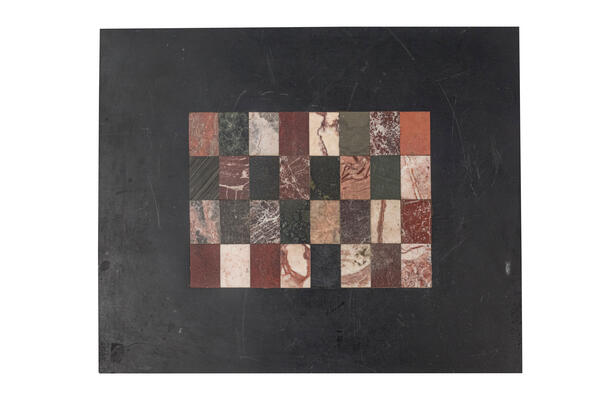Shungite is a black or dark gray rock. The stratified shungite-bearing deposits can be found only in Karelia. Shungite got its name from the old village of Shunga, near which the deposits were first discovered and examined.
The tabletop from the museum’s collection was made of shungite by an unknown artist from the village of Tivdia. Today, it is the territory of Kondopozhsky District of Karelia. In the central part of the tabletop, there is an inlay of thirty-two rectangular samples of Tivdian marble. Some researchers claim that this exhibit is not a tabletop, but a merchant’s board, a kind of “advertisement” of marble quarries in Tivdia.
The Tivdian marble quarries were a large-scale production. Already in the second half of the 18th century, Karelian marble was known throughout Russia and was used in the construction of St. Isaac’s Cathedral and the Kazan Cathedral, the Marble Palace and the Winter Palace. Karelian marble was quarried in different shades: white, pink, reddish, black, gray-green, yellow, even striped and spotted. Until 1844, twenty-three types of marble were known, later eight more were discovered.
Tivdian marble began to be quarried in the first half of the 18th century. The industrial exploitation was organized in the villages of Tivdia and Belaya Gora. The Tivdian Marble Factory worked in 1807–1892.
Tivdian marble was considered one of the best varieties of marble. It was treated carefully, due to differences in the hardness of individual parts of the rock — the surface could be uneven. The atmosphere has a powerful effect on this material. It can be polluted by smog and the upper layer can get coated with a white gypsum deposit because of rains. Therefore, Tivdian marble was most often used inside the buildings.
At the end of the 19th century, marble quarries fell into disrepair. Only twenty peasants were engaged in the marble trade. They created paperweights, cutting boards, ashtrays, small vases, chess boards, candlesticks, decorations for dining and cabinet tables in the form of pyramids, and other items.
The tabletop from the museum’s collection was made of shungite by an unknown artist from the village of Tivdia. Today, it is the territory of Kondopozhsky District of Karelia. In the central part of the tabletop, there is an inlay of thirty-two rectangular samples of Tivdian marble. Some researchers claim that this exhibit is not a tabletop, but a merchant’s board, a kind of “advertisement” of marble quarries in Tivdia.
The Tivdian marble quarries were a large-scale production. Already in the second half of the 18th century, Karelian marble was known throughout Russia and was used in the construction of St. Isaac’s Cathedral and the Kazan Cathedral, the Marble Palace and the Winter Palace. Karelian marble was quarried in different shades: white, pink, reddish, black, gray-green, yellow, even striped and spotted. Until 1844, twenty-three types of marble were known, later eight more were discovered.
Tivdian marble began to be quarried in the first half of the 18th century. The industrial exploitation was organized in the villages of Tivdia and Belaya Gora. The Tivdian Marble Factory worked in 1807–1892.
Tivdian marble was considered one of the best varieties of marble. It was treated carefully, due to differences in the hardness of individual parts of the rock — the surface could be uneven. The atmosphere has a powerful effect on this material. It can be polluted by smog and the upper layer can get coated with a white gypsum deposit because of rains. Therefore, Tivdian marble was most often used inside the buildings.
At the end of the 19th century, marble quarries fell into disrepair. Only twenty peasants were engaged in the marble trade. They created paperweights, cutting boards, ashtrays, small vases, chess boards, candlesticks, decorations for dining and cabinet tables in the form of pyramids, and other items.



